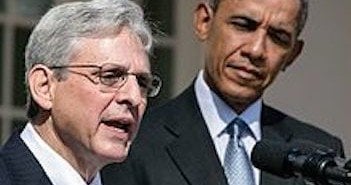Obama’s Nominee and the Oklahoma City Bombing
The first thing President Barack Obama mentioned in his nomination of Merrick Garland to the Supreme Court was his role in the Oklahoma City bombing. It was, Garland said, “the most important thing I have ever done in my life.”
According to reports, within moments of news on April 19, 1995, that 168 people including 19 children had been killed in what was until then the deadliest terrorist attack on national soil, Garland asked to be sent to the crime scene to manage the investigation. At the time he was principal associate deputy attorney-general, a top aide to Deputy Attorney General Jamie Gorelick, in Janet Reno’s Justice Department. Garland was at the scene three days later and oversaw the investigation first-hand. Although he returned to Washington a short time after to supervise other criminal cases including Oklahoma City, he continued in an advisory role. Eventually Timothy McVeigh was tried and sentenced to death.
Much has been written about the man who planned and executed the bombing but within the Oklahoma City National Memorial Museum, he is barely referenced.
The Museum was dedicated some months before the sixth anniversary of the bombing. Although inspired by the United States National Holocaust Memorial Museum, it tells a much simpler story without considering root causes or problematic aspects, reflecting what one scholar described as American “democratic optimism and a susceptibility to easy consolation.” Arranged by installations referred to as chapters, it ends with a message of triumph and hope.
The investigation of the crime is addressed in Chapter 9: “Behind the Scene: The Oklahoma Bomb Investigation” that follows and documents the collection of evidence that led to the arrests. McVeigh is mentioned only in a small section devoted to his trial and conviction. According to curator Heidi Vaughn, “We didn’t want to make a big deal out of him. But he is part of the story.” Arguably, he is the key to understanding the story. How did his history in and with the military influence his subsequent behavior? What role did his rejection by the Special Unit Forces after his honorary discharge from the military play? There are many more pertinent questions. Around the time of McVeigh’s impending execution the Southern Poverty Law Center’s Intelligence Report was devoted to the current status of the patriot movement. It is a good example of what might have been included in the museum to prompt a more thoughtful discussion.
Chairs at Oklahoma memorial function as headstones
On September 16, 2014, the museum opened a second floor with a number of “enhancements”: a 40-foot glass overlook and a new installation detailing the capture and prosecution of Timothy McVeigh. The overlook enables visitors to view the memorial from the museum. According to the director of the memorial and museum, Kari Watkins, it “is meant to break out of the old and ‘overlook’ this memorial that’s meant to be, not a cemetery, but a place of celebrating life.”(1) However, since the chairs – the central element of the memorial – both evoke and occasionally function as headstones, it is difficult to interpret the complex as other than a symbolic cemetery.
The new installation is “dedicated to telling the story of the investigation and justice.”(2) Intended to appeal to younger viewers, it incorporates technology with touch screens and interactive applications. There are also actual objects that once belonged to McVeigh, his car as well as his gun, knife and driver’s licence, which were not available earlier. Documents delineate the process that led to his arrest and what followed, highlighting the various roles of the individuals involved and thereby echoing the narrative of triumph expressed in the exhibition below. The victims of the bombing continue to be honored as people who gave their lives for their country. What is enhanced are the frames of McVeigh the criminal and local residents as heroes, or as the website proclaims, the installation “contrasts the brutality of the event with the tenderness of the response.”(3) Although twenty years have passed, there are no reflections about McVeigh’s motives or the broader implications of his act and the beliefs that prompted it.

On the 20th anniversary of the bombing in 2015, Merrick Garland, along with his fellow prosecutors, defence team and the judges involved, were given the Reflections of Hope Award, awarded annually to “a living person or group whose extraordinary work has significantly affected a community, state or nation.” Perhaps at the time Garland specified precisely how the Oklahoma City bombing and his role in the case influenced him but I have seen no reports of such. He has been praised for his hands-on approach, thoroughness, and even-handedness to all involved. Understanding what called him to volunteer immediately and what this experience has meant to him (besides a lot) might elucidate further what kind of a Supreme Court Judge he might be, and perhaps also shed more light on what motivated Timothy McVeigh. Certainly the memorial does nothing of the sort.
- Lawrence Graver quoted in Hilene Flanzblaum, ed. The Americanization of the Holocaust (Baltimore: Johns Hopkins University Press, 1999), 4.
- Watkins is quoted in Kyle Schwab, “Oklahoma National Memorial & Museum Now Features Timothy McVeigh’s Car,” September 15, 2014, available at http://newsok.com/0klahoma-city-national-memorial-museum-now-features-timothy-mcveighs-car/article/5342139; accessed February 20, 2015.
- Schwab, “Oklahoma City National Memorial & Museum Now Features Timothy McVeigh’s Car.”
© 2016 Harriet F. Senie, author of Memorials to Shattered Myths: Vietnam to 9/11
